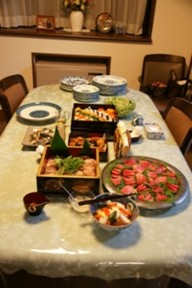In Japan, traditionally, the new year is the most important religious ceremony. Most people have five days holidays, from December 30 to January 3. Though it is a cold period, most clean their houses thoroughly. Tatami mats are exposed outside in the sun and air, paper slides, or shojis, are recovered with new paper, curtains are washed, walls and furniture are dusted and cleaned, new dishes and chopsticks are prepared. Such preparations are mostly done by December 30. On December 31, the last day of the year, people must repay any debt they have before midnight. Housewives cook new year special dishes – traditional ones. There are usually about 30 kinds and they differ according to the local areas. For example, each family or local area has a soup with different ingredients, flavour and taste. For example, beans paste soup, salt and sea weed soup, dried shrimp, or mushroom soup and so on. Usually, one or two pieces of rice cake will be cooked together in two shapes, round or square. The rice cake is made before the new year. When I was young, our neighbours gathered and steamed glutinous rice in the early morning. After it is done, strong men would knead it with a big wooden hammer-like tool in a vast wooden vat. After it became really smooth, women would make the paste into flat, round shape or cut into squares. Each dish has its special meaning and wish, such as joy in life, health, longevity, prosperity and so on.
We also eat special noodles made of buck wheat, listening to sounds of nearby temple bell. The ringing starts just before midnight. The huge gong is struck 108 times and this figure symbolises 108 kinds of human sins! We believe, listening to it will purify us from our sins of the year. Some people enjoy a special New Year TV program called kokuhaku, which is a battle of songs by women and men, in which one team wears read and the other white. The costumes are amazingly flamboyant and creative. Last year the women’s team won after some years of defeats. I personally don’t watch it, but enjoy the quiet night writing my diary summarizing 2011.
Then comes the first of January. This year, we celebrated it with special sake – otoso– in a lacquerware, to pray to Japanese gods for our health, wealth, happiness. Also new year dishes are arranged beautifully in square lacquer ware boxes. These boxes are usually black with gold designs of plum blossoms, clams or ferns symbolizing sacred and auspicious things for new year. Our three elder daughters are married, so we celebrated with our youngest, Akiko.
After a hearty meal, it was time for us to open new year cards. In Japan, most people use this occasion to greet each other and to inform about the events of the year gone by, such as moving house, a new family member’s arrival, marriage and so on. It is such a tedious work to prepare about 200 cards in December, but it is a great a joy to read cards from friends.
Nobi, my husband, and I visit our relatives to celebrate the first three days of the year together. It is the biggest occasion to have family gatherings. As our relatives mostly live in Tokyo and nearby prefectures, it is not difficult to gather, but some people need to travel far to visit their parents or relatives and traffic jams are terrible during this visiting period.
On the fourth of January, most companies begin their regular business. Supermarkets or convenience stores open earlier.
We decorate our gates or entrance doors with new year ornaments and they are taken down on January 7. It is also a tradition to eat vegetable porridge to ease our stomach after feasting too much! I don’t like porridge, so I don’t make it. The vegetables should be of seven special kinds and you can buy them as a bunch at any supermarket or grocery store. Some people pile two big rice cakes on top of which fern and orange are put. All of them are symbols of new year’s wishes. To cut these rice cakes into pieces is also a traditional annual event on new year’s day. After eating all the dishes and removing ornaments, we finish our new year holiday and start working as usual with big stomachs and a few extra pounds!
Yuriko Iseki is a housewife and lecturer at culture schools for adults She lives in Nakano, Tokyo, with her husband and loves her four daughters, birds, flowers, literature, travels, and music.







Nostalgia! Brings back wonderful memories of happy happy new year celebrations in Japan, Thank you for the memories. 🙂
I thoroughly enjoyed reading about the New Year Celebration in Japan. I am very interested to know the various cultures of the world. Your article is very interesting and would love to read more about your country…